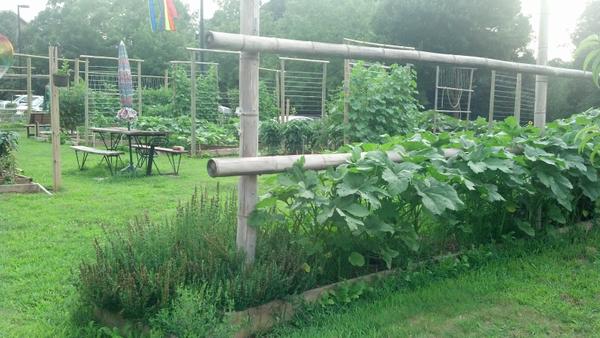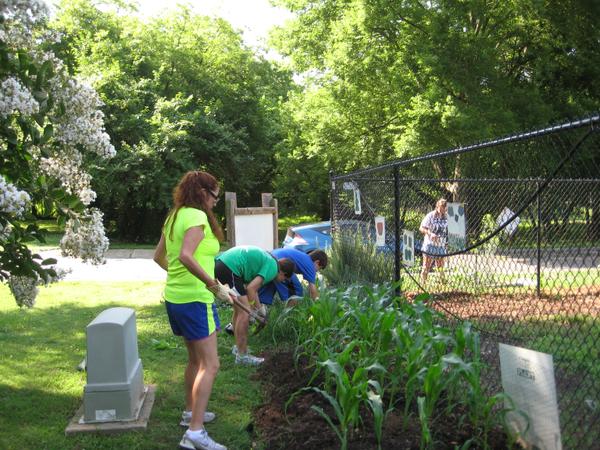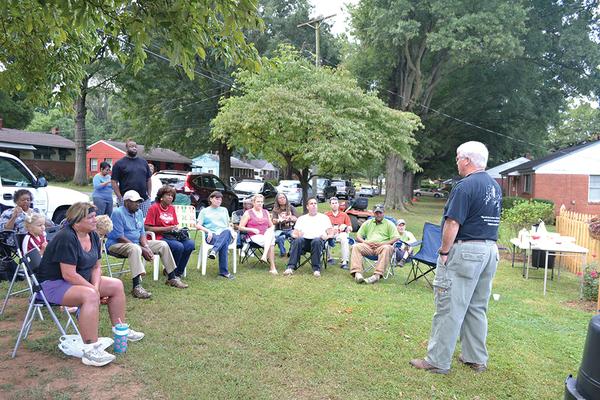Introduction
This tool for organizing and managing a community garden in North Carolina covers the entire process, from the first steps in organizing a new garden to long-term strategies to keep gardens flourishing over time. Our goal is to encourage the creation of successful and sustainable community gardens that benefit citizens across our state for decades to come.
What is a community garden?
The Brooklyn Botanic Garden’s book, Community Gardening (Kirby and Peters 2008), defines a community garden as “anywhere a community of people joins together to garden.” By their nature, community gardens are highly diverse. Some target a special population—for instance, homeless people or recent immigrants. Others provide horticultural therapy to those with physical or developmental challenges or offer a soothing sanctuary for patients in hospice care. Community gardening programs include wildflower meadows, street tree projects, and outdoor gathering places for neighborhoods.
Community gardens have long been part of the American landscape. In 1759, Moravian immigrants established Bethabara Garden in Old Salem, North Carolina, North America’s first documented colonial community garden. Bethabara is still an active community garden today.
Modern community gardens come in an endless variety of sizes, shapes, and purposes, from tiny pocket parks to expansive urban farms. They are as culturally diverse as America itself. In spite of their differences, however, all community gardens share something essential in common. Whether it’s a church project to grow food for the hungry, a market garden to engage urban youth in an entrepreneurial adventure, or a traditional allotment garden where families rent plots to grow vegetables for themselves, a community garden’s success depends directly on the gardeners and how actively they support their garden.
Benefits of community food gardening
In this publication we focus on community food gardens, defined as community gardens that make growing food their top horticultural priority.
Community food gardens boast a long list of benefits, from improving access to fresh food to building stronger neighborhoods. Community food gardeners and their families eat a wider variety and larger quantity of fresh fruits and vegetables, leading to an overall improvement in nutrition. The gardens’ harvests also help reduce grocery bills. Some gardeners supplement their incomes by marketing a portion of the produce they grow. Being involved in a community garden also increases gardeners’ physical activity and overall health. Gardening can reduce stress, muscle tension, and high blood pressure. In addition, community gardens invite people of all ages and backgrounds to cooperate, work, and socialize together. A community garden can transform a group of separate individuals who happen to live in the same place into a community. The organizational and leadership skills gardeners learn while working with their community gardens help them become more effective and engaged citizens.
Community Food Gardens: Plots and Co-Ops
Community food gardens can be organized as a collection of individual plot gardens, as one large cooperative garden, or as a combination of the two.
Plot Gardens
Community food gardens with individual plots, similar to allotment gardens in the United Kingdom, are subdivided into individual gardening areas. Plots normally range in size from 100 to 500 square feet. Gardeners are responsible for planting, maintaining, and harvesting their own plots, and the harvest is usually for the gardener’s home consumption. A well-established variation on plot gardens, especially in urban areas, provides gardeners with raised beds instead of plots. Raised beds average 32 to 60 square feet.
Cooperative Gardens
In a cooperative community food garden, a group of gardeners work together to manage the entire space as a single large production garden. The harvest may be distributed equitably to member gardeners, donated to food banks or soup kitchens, or sold at local farmers’ markets as an entrepreneurial project.
Each strategy has advantages and disadvantages. Plot gardens allow more personal control over what to grow and how to grow it; however, they require gardeners to have knowledge and experience and be committed to managing the plot for the entire season. Cooperative gardens are more accessible to gardeners because individuals can join any time in the growing season with no prior knowledge or experience, and gardeners can contribute as much or as little time as they want. It is also easier to manage crop rotation in a cooperative garden. However, some cooperative gardens tend to be directed “top down” and may not allow gardeners to take a meaningful role in decision-making and leadership.
Experience shows that either strategy can be used to create a successful and sustainable community garden. Both approaches benefit greatly from appropriate location, layout, and management as well as ongoing community engagement.
Mixing Plots and Co-Ops
A community food garden may offer a mix of individual plots and cooperative areas. For example, a plot garden may set aside a cooperative gardening area for space-hungry crops, such as corn or watermelons, or for collaborative efforts to grow fruit trees, bushes, and vine crops.

Donna Teasley CC BY-SA 4.0

Lucy Bradley CC BY-SA 4.0
Organizing a Garden: A Quick Overview
There are two distinct phases in establishing a community food garden: starting the garden and managing the garden. Both are equally important. A community garden’s success is determined not by how good it looks on opening day but on whether gardeners are still successfully gardening there ten years later.
Starting the Garden
Starting a new garden begins with forming a group—a garden team—to manage the many tasks needed to organize and set up the garden, from finding a site, to recruiting gardeners, to improving the soil. The timeline for the start-up phase depends on many factors. Three to six months from starting to opening day is possible but optimistic. A year is more realistic.
Managing the Garden
Community food garden management continues throughout the life of the garden. Management involves taking care of the gardeners as well as the garden. Communication, publicity, fundraising, and community engagement are also critical factors. During the management phase, the garden team ideally evolves into a garden-based organization as gardeners take on increasing responsibilities.
Is a Food Garden the Right Project?
Before starting any community food gardening project, organizers must thoughtfully discuss if a food garden is the right project to pursue.
- Do potential gardeners and their neighborhood or organization want a community food garden?
- Will a community food garden meaningfully address the needs and hopes of the community and the gardeners?
- Is there another food garden in the area that could be expanded rather than creating a new garden?
The self-defined needs of the community must come first, because without community support the garden will likely fail. For instance, if neighborhood youth dream of a place to play soccer, creating a soccer field on a vacant lot may make more sense than using it to grow vegetables.
The best way to answer this question is to go into the community to discuss the proposed garden in one-on-one and street corner conversations as well as at formal informational meetings.
In areas where community gardens are unfamiliar, raise awareness by educating people about the many benefits these gardens bring to the community. At the same time, balance personal enthusiasm for community gardening with a commitment to listening respectfully to everyone, including those voicing questions, concerns, and criticism.
Publication date: Aug. 10, 2017
AG-806
Other Publications in Collard Greens and Common Ground: A North Carolina Community Food Gardening Handbook
N.C. Cooperative Extension prohibits discrimination and harassment regardless of age, color, disability, family and marital status, gender identity, national origin, political beliefs, race, religion, sex (including pregnancy), sexual orientation and veteran status.




